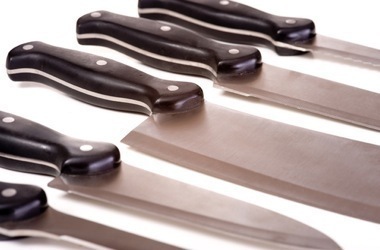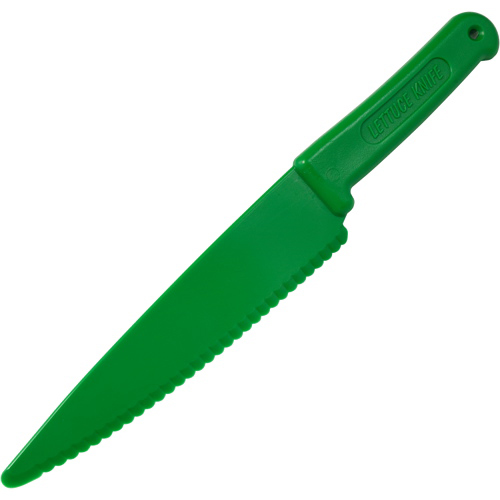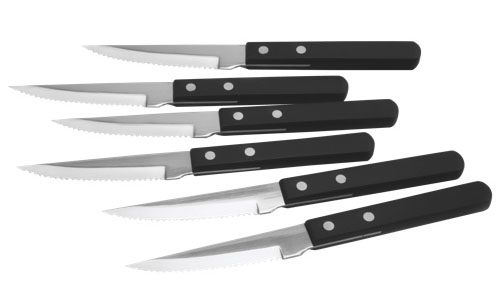 A few days ago I went grocery shopping, and as I was paying, the cashier asked me if I was collecting stamps. “Stamps for what?” I asked. “Stamps for new knives” she enthusiastically replied. To be honest, I’d never really given much thought to knives before. I mean, I have a set that I got when I first moved out many moons ago, but I took my stamp and went on my merry way. Later, I was flipping through the knife brochure that came with my stamp and after about page 6, I started thinking – why are there so many different types? What knife is for what? Do you really need 18 or will two do? As it turns out, you do! Here’s a breakdown of what makes one knife different from another.
A few days ago I went grocery shopping, and as I was paying, the cashier asked me if I was collecting stamps. “Stamps for what?” I asked. “Stamps for new knives” she enthusiastically replied. To be honest, I’d never really given much thought to knives before. I mean, I have a set that I got when I first moved out many moons ago, but I took my stamp and went on my merry way. Later, I was flipping through the knife brochure that came with my stamp and after about page 6, I started thinking – why are there so many different types? What knife is for what? Do you really need 18 or will two do? As it turns out, you do! Here’s a breakdown of what makes one knife different from another.

As the name implies, a boning knife is specifically designed to remove the main bones within a cut of meat or poultry. It’s sharp point makes it easy to pierce flesh, and its long, narrow blade allows the user to closely follow and manipulate around bones for precision boning. To prevent injury from the blade bending too easily, stiffer blades should be used for larger cuts of meat, while more flexible blades can be used for smaller cuts of meat.

Again, as the name implies a bread knife is used to cut bread. Their blades of a bread knife can be either straight or slightly curved but always feature a serrated edge, which is designed to slice through a bread’s tough outer skin or crust without crushing its soft, doughy interior. These knives can also be used to cut through hard rind fruit, such as pineapple and watermelon as well.

While some chefs use carving knives as a general purpose knife in place of a chef’s knife, the intended purpose of a carving knife is to slice meat. They are long with a blade that is thinner than that of a chef’s knife – particularly at the spine – which makes them ideal for carving thin, precise slices of poultry, roast, ham, and other large cooked meats.

Also known as a cook’s knife, a chef’s knife is a versatile, multi-purpose knife designed to perform a wide variety of tasks, making it a necessity for any kitchen. Originally designed to slice and disjoint large cuts of beef, today’s chef knives can be used to mince, dice, slice and chop a variety of different food products. Generally speaking, a chef’s knife features a blade that is 8” long and 1.5” wide, with either a French or German blade shape. French blades feature a continuous curve along the whole cutting edge, while German blades feature a straighter cutting edge that curves up at the tip. Whether you choose French or German comes down to personal preference as both are equal in their ability to get the job done.

Who knew there was a knife just for lettuce! Made of plastic and featuring a serrated edge, lettuce knives are designed to slice lettuce without causing the edges of the lettuce to turn brown, which is the case when lettuce is cut with a metal blade.

Used to filet, bone, and remove scales from fish, a fillet knife features a long (typically 6” to 11”), thin, and flexible blade with a pointed tip. The narrow blade is specifically designed to move cleanly along the backbone and under the skin of fish.

Nakiri knives are of Japanese origin and are intended for cutting greens and Japanese-style vegetables. Their unique shape is similar to that of a cleaver, with a straight, thin blade edge that eliminates that cuts all the way to the cutting board, eliminating the need to pull or push the knife horizontally though the vegetables.

Paring knives are general purpose knives that are typically used for small, intricate work like peeling, de-seeding, coring, or skinning. The blades of paring knives range in length from about 3” to 5” and vary depending on the intended use. A “bird’s peak” paring knife has an arched blade that is ideal for peeling round fruits; a “sheep’s foot” paring knife has a blunt blade that maximizes contact between food and blade so it’s ideal for smaller foods like shallots and garlic; and a “spear point” paring knife – also called a chef’s parer because of its versatility – has a sharp tip so is ideal for peeling, slicing, removing stems, and other precision cutting tasks.

These knives are general-purpose knives of Japanese origin and are very similar to chef’s knives with a long, wide, straight edged blade that curves up to a point at the end. The word “Santoku” means “three virtues” or “three uses” and in the case of the Santoku knife, those uses are slicing, dicing, and mincing. Typically, the blades of these knives range in size from 5” to 8” although there are smaller ones available. Best known for their razor sharp edges, Santoku knives are designed for a comfortable, balanced grip.
Unlike the rest of the knives in this list, steak knives are used after meal preparation, not during. Typically sold in sets of four or six, steak knives are used to cut steak, chicken, pork, and other main course entrees. They typically feature a blade that is 4” to 6” long, and depending on the manufacturer, a serrated, or non-serrated blade.

Also called a sandwich knife, utility knives are typically larger than paring knives but smaller than slicing knives, making them perfect for slicing small pieces of meat as well as herbs, fruits, vegetables and larger pieces of garlic. The blades of utility knives measure between 4” and 7” long and are either straight-edged or serrated. It’s worth noting that these days, multi-purpose knives, like Swiss Army knives are also called utility knives, but those aren’t exactly the kind of tool you want to use in your kitchen!
So there you have it! As you can see, even when a knife looks like another knife, their intended uses may be very different. Also, it’s worth noting that this list is by no means complete. There are myriad other knives on the market designed for a variety of unique uses. You can find clam knives and oyster knives, which are specifically designed to (you guessed it) open the shells of clams and oysters. There are also butter knives and cheese knives, and even bagel slicers and tomato knives. And, of course, if you like to butcher your own meat, you can’t go wrong with a cleaver. As for me, I think it’s time for to upgrade my few knives for “adult” versions and stop cutting bread with a steak knife.
Check out the full range of knives available at Best Buy here. And for more information check out the Best Buy knife buying guide





And Best Buy also carries accessories to keep them in top condition!
http://www.bestbuy.ca/Search/SearchResults.aspx?query=knife+sharpener
I will have to use this new found knife knowledge to impress my wife!
Comments are closed.